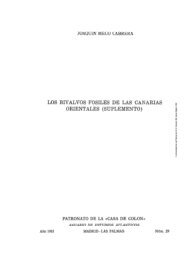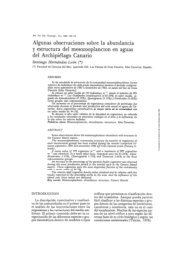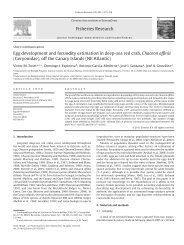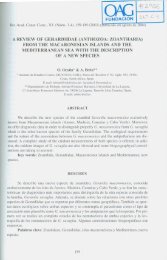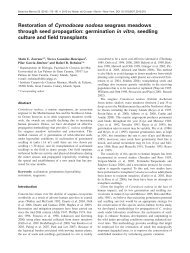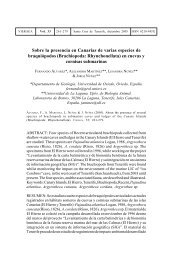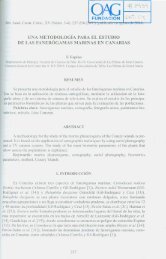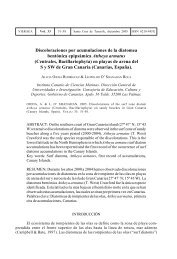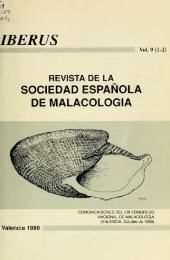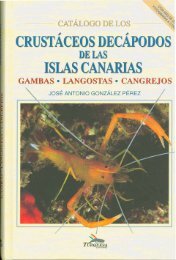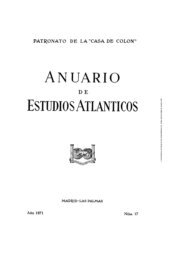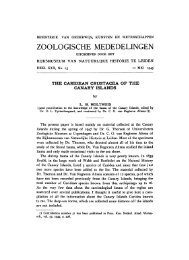of the madeira and selvagens archipelagos - redmic
of the madeira and selvagens archipelagos - redmic
of the madeira and selvagens archipelagos - redmic
Create successful ePaper yourself
Turn your PDF publications into a flip-book with our unique Google optimized e-Paper software.
Borboletas (Insecta, Lepidoptera)<br />
Existem três espécies e duas subespécies endémicas de<br />
borboletas na ilha da Madeira. As duas espécies endémicas<br />
seleccionadas para este estudo, ambas desempenh<strong>and</strong>o<br />
um papel muito importante nos ecossistemas, apresentam<br />
diferenças significativas nas abundâncias e nos habitats preferenciais<br />
onde ocorrem (Wakeham -Dawson et al. 2002).<br />
– Gonepteryx maderensis Felder, 1862 (Pieridae) (Fig. 6a).<br />
Segundo dados publicados e registos dos autores deste<br />
estudo, esta espécie está associada à copa da floresta<br />
húmida de Laurissilva. Existem poucos registos da presença<br />
desta espécie fora da área de distribuição da Laurissilva<br />
e os indivíduos pontuais encontrados noutros habitats<br />
devem ter sido provavelmente levados por ventos<br />
fortes. É frequente observar adultos desta espécie a voar<br />
de Fevereiro a Setembro, entre os 300 e os 1700 m de<br />
altitude. Não é uma espécie rara, mas pode -se dizer que<br />
é tão pouco frequente como a única espécie de planta da<br />
qual se alimenta, o sanguinho da Macaronésia.<br />
– Hipparchia maderensis (Bethune -Baker, 1891) (Nymphalidae)<br />
(Fig. 6b). Os registos disponíveis sobre esta<br />
espécie indicam que ocorre em qualquer altitude, mas é<br />
particularmente comum em áreas acima dos 1000 m. As<br />
lagartas alimentam -se de várias espécies de Poaceae.<br />
É frequente observar muitos indivíduos adultos no gr<strong>and</strong>e<br />
planalto da ilha da Madeira, Paúl da Serra, desde o<br />
fim da Primavera até ao fim do Verão.<br />
Aves<br />
A selecção dos taxa de aves a considerar para este estudo<br />
foi feita com base no tipo de colonização, na sua distribuição,<br />
no tipo e área de habitat disponível, na abundância<br />
e na exactidão dos dados das espécies. Os dados de distribuição<br />
utilizados nos modelos são o resultado de um trabalho<br />
de campo muito exaustivo, que se desenvolveu durante<br />
a época de nidificação, de Fevereiro a Julho, durante os<br />
anos de 1999 a 2002. Foram realizados 90 transectos de<br />
2 horas cada, segundo uma grelha geo -referenciada (UTM)<br />
de 2×2 km (para mais detalhes ver Oliveira & Menezes<br />
2004). Espera -se que os modelos preditivos de distribuição<br />
ajudem a explicar as razões que levam a uma presença<br />
quase exclusiva de subespécies endémicas raras em áreas<br />
com uma forte influência humana (directa ou indirecta), tais<br />
como áreas de floresta exótica, áreas agrícolas e habitats<br />
naturais perturbados.<br />
– Anthus ber<strong>the</strong>lotii Bolle, 1862 (Motacillidae) (Fig. 7a), conhecida<br />
como Corre -caminhos, é uma espécie endémica<br />
da Macaronésia, que ocorre exclusivamente nos arquipélagos<br />
da Madeira e das Canárias e que compreende duas<br />
subespécies: A. b. madeirensis e A. b. ber<strong>the</strong>lotii. Anthus<br />
ber<strong>the</strong>lotii madeirensis (Erlanger, 1899) está apenas presente<br />
na ilha da Madeira, onde apresenta uma distribuição<br />
fragmentada, com preferência para terrenos rochosos<br />
e de baldio, em áreas abertas, a qualquer altitude.<br />
– Carduelis chloris Linnaeus, 1758 (Fringillidae) (Fig. 7b)<br />
44<br />
Butterflies (Insecta, Lepidoptera)<br />
There are three endemic species <strong>and</strong> two endemic subspecies<br />
<strong>of</strong> butterflies on Madeira Isl<strong>and</strong>. The two endemic<br />
species selected, both equally important in <strong>the</strong>ir ecosystems,<br />
show considerable differences in terms <strong>of</strong> abundance<br />
<strong>and</strong> preferred habitats (Wakeham -Dawson et al. 2002).<br />
– Gonepteryx maderensis Felder, 1862 (Pieridae) (Fig. 6a),<br />
known as <strong>the</strong> Madeiran Brimstone, is intimately associated<br />
with <strong>the</strong> humid Laurisilva forest canopy, as indicated<br />
in our own records <strong>and</strong> o<strong>the</strong>r publications. Very few records<br />
fall outside <strong>the</strong> Laurisilva distribution area <strong>and</strong> <strong>the</strong>se<br />
few records are probably isolated specimens driven<br />
out <strong>of</strong> <strong>the</strong>ir habitats by strong winds. Adults have been<br />
seen flying from February thru September, between 300<br />
<strong>and</strong> 1,700 m.a.s.l. The Madeiran Brimstone is not a rare<br />
species but can be considered scarce since it only has<br />
one known food -plant, <strong>the</strong> Macaronesian Buckthorn.<br />
– Hipparchia maderensis (Bethune -Baker, 1891) (Nymphalidae)<br />
(Fig. 6b) is commonly known as <strong>the</strong> Madeiran<br />
Grayling. The records indicate that it can be found at<br />
almost all altitudes, but it is fairly common above 1,000<br />
m.a.s.l. where its preferred habitat is located, <strong>and</strong> its caterpillars<br />
feed on several species <strong>of</strong> Poaceae. One <strong>of</strong> <strong>the</strong><br />
best places to observe this endemic nymphalid butterfly is<br />
at <strong>the</strong> top <strong>of</strong> <strong>the</strong> isl<strong>and</strong>’s only large plateau, Paúl da Serra,<br />
where hundreds <strong>of</strong> individuals can be seen flying from late<br />
spring throughout <strong>the</strong> summer.<br />
Birds<br />
The selection <strong>of</strong> bird taxa used for this analysis was based<br />
on <strong>the</strong>ir degree <strong>of</strong> endemism, patchy distribution, type<br />
<strong>and</strong> area <strong>of</strong> available habitat, low abundance <strong>and</strong> quality<br />
<strong>of</strong> data. The data used in <strong>the</strong> simulations are <strong>the</strong> result <strong>of</strong><br />
extensive fieldwork, which took place during <strong>the</strong> nesting<br />
seasons, February to July, from 1999 to 2002. Ninety transects<br />
<strong>of</strong> 2 hours were performed along a georeferenced grid<br />
(UTM) <strong>of</strong> 2×2 km (for fur<strong>the</strong>r details see Oliveira & Menezes<br />
2004). It is expected that <strong>the</strong> predictive distribution models<br />
will help explain <strong>the</strong> factors that dictate <strong>the</strong> almost exclusive<br />
presence <strong>of</strong> uncommon endemic subspecies in areas with<br />
a strong direct or indirect human influence (exotic forest,<br />
farml<strong>and</strong> <strong>and</strong> disturbed natural habitats).<br />
– Anthus ber<strong>the</strong>lotii Bolle, 1862 (Motacillidae) (Fig. 7a),<br />
known as <strong>the</strong> Ber<strong>the</strong>lot’s pipit (Corre -caminhos), is a<br />
species endemic to Macaronesia, occurring exclusively<br />
on <strong>the</strong> <strong>archipelagos</strong> <strong>of</strong> Madeira <strong>and</strong> <strong>the</strong> Canary Isl<strong>and</strong>s,<br />
<strong>and</strong> is comprised <strong>of</strong> two subspecies: A. b. madeirensis<br />
<strong>and</strong> A. b. ber<strong>the</strong>lotii. Anthus ber<strong>the</strong>lotii madeirensis (Erlanger,<br />
1899) can be found only on Madeira Isl<strong>and</strong>, where<br />
it has a patchy distribution, favouring rocky, open <strong>and</strong><br />
scrubby terrain at all altitudes.<br />
– Carduelis chloris Linnaeus, 1758 (Fringillidae) (Fig. 7b),<br />
known as <strong>the</strong> Greenfinch (Verdilhão), is a native species<br />
<strong>of</strong> Madeira Isl<strong>and</strong>. It favours areas <strong>of</strong> exotic forest, mixed<br />
forest near farml<strong>and</strong> <strong>and</strong>/or open patchy scrub areas. It



